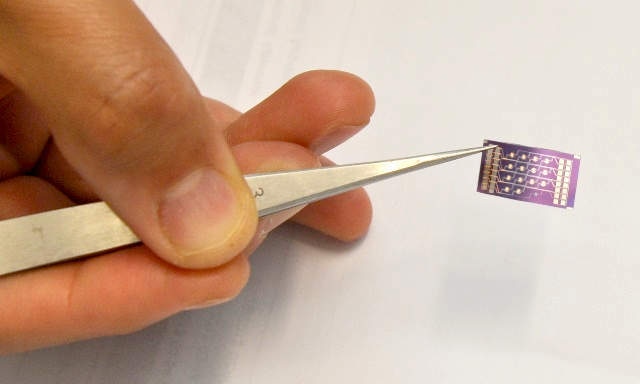By Kalwinder KaurJun 14 2013
Foodborne diseases continue to grow as a global burden including microbial, parasitic and chemical contamination of food products.
Some of the conventional methods that have been used to measure the level of contamination in food products include techniques such as immunomagnetic separation that can isolate strains specific to a particular antigen; and the polymerase chain reaction process which helps identify the genes for the target organisms.

The nano sensor array developed by Nosang Myung. Image courtesy of Professor Nosang Myung, University of California, Riverside.
In combination, both techniques can reduce assay time and increase the sensitivity of detection for pathogens in a sample. However, being able to identify DNA in a food sample doesn’t necessarily indicate that the organism linked to the isolated DNA is a living organism. Though both techniques offer increased sensitivity and selectivity, recent efforts are focusing on being able to miniaturise these techniques into sensor devices.
The food health and safety industry will start to see an influx of new lab-on-chip technology that will aim to speed up the diagnostics process for identifying pathogens in the food supply industry.
An interesting development that now becomes key to this industry is research by Nosang Myung, Professor of Chemical and Environmental Engineering at the University of California, Riverside.
Professor Nosang Myung is part of a research project being commercialized by Innovation Economy Crowd (ieCrowd), and has developed a nano-sensor that helps isolate deadly pathogens in food products.
How does it work?
The carbon nanotube material on biosensors will increase the sensitivity of detection based on the principle that when a DNA samples attaches to the nanotube, the conductivity changes and the electrodes generated then provide a measure of detection of the pathogen.
If a pathogen’s DNA concentration levels are too low for the detection level, under a PCR technique, this DNA is amplified to help identify the nature of the contaminant. However, nanotubes that generate a response based on excellent conductivity will provide a fast and accurate measure of the smallest level of pathogenic contamination of food; whereas, conventional methods would need more than just changes in electrical resistance to provide a measured response.
The advancement of sensor devices for pathogen detection could as such reduce the time required to label DNA samples. The current nano-sensor by professor Nosang Myung is made up of carbon nanotubes designed to detect bacterial and pathogenic contaminants to a concentration of parts per billion.
Future Developments
Nano-sensors clearly have a solid future in the detection of pathogens in the food supply industry. A market analysis of the application of biosensors for the food industry estimated a market potential for these products at $150 million on an annual scale – an encouraging figure reflecting a great demand in this market area.
The development of a sophisticated nano-sensor for the detection of food contamination will help bring to light how substances such a pesticides, which are used to prevent damage to plants for the purpose of food and medicine, are directly contaminating such consumable products.
Pesticides not only affect the food and water we consume but also the environment that can be directly affected by leaching of these toxins into the soil and surrounding rivers and lakes, hence there will be a great opportunity for the commercialisation of miniaturised pathogen detection tools for a vast number of applications in industry.
References
- Nugen S.R., et al. Trends and opportunities in food pathogen detection. Anal Bioanal Chem. 2008 May; 391(2): 451–454.
- Singh A., et al. Recent Advances in Bacteriophage Based Biosensors for Food-Borne Pathogen Detection. Sensors 2013, 13(2), 1763-1786
- WHO - Burden of foodborne diseases
- Olsvik O., et al. Magnetic separation techniques in diagnostic microbiology. Clin. Microbiol. Rev. 1994, 7(1):43.
- Alocilja EC, Radke SM. Market analysis of biosensors for food safety. Biosens Bioelectron. 2003 May;18(5-6):841-6.
Disclaimer: The views expressed here are those of the author expressed in their private capacity and do not necessarily represent the views of AZoM.com Limited T/A AZoNetwork the owner and operator of this website. This disclaimer forms part of the Terms and conditions of use of this website.